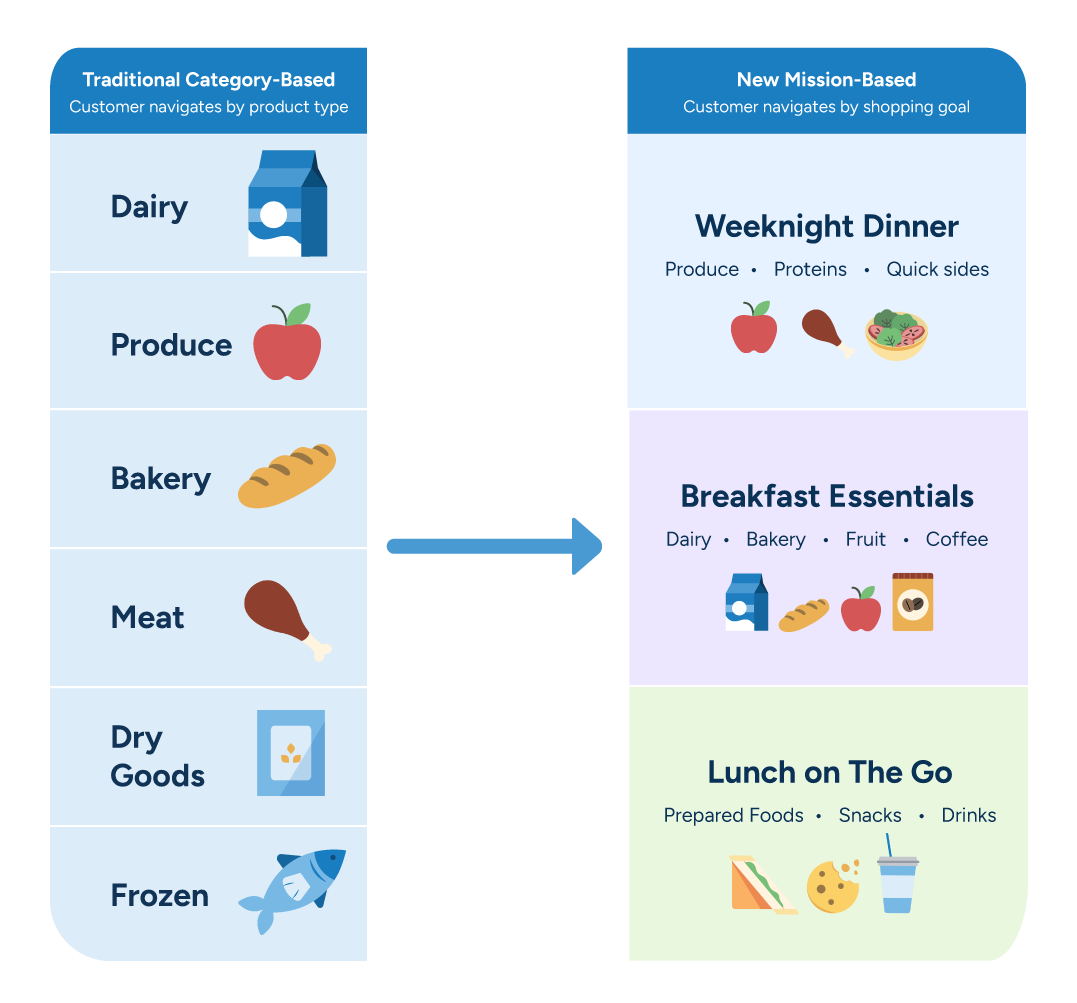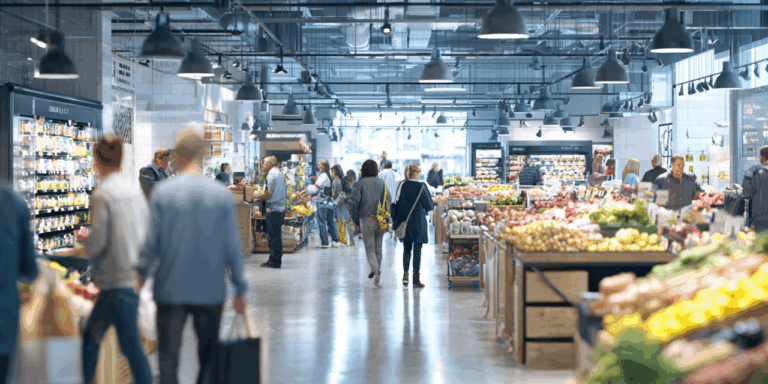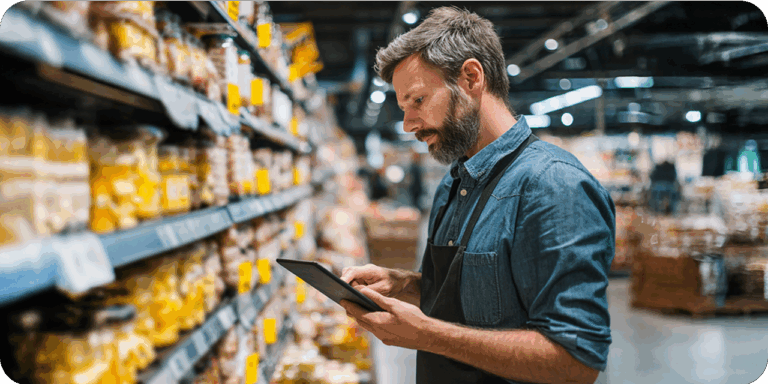Optimizing space and assortment for hybrid shopping
May 2, 2025 • 7 min
Shopping used to be simple. When you needed something, you went to a store, browsed the shelves, and chose from what was available. But that’s not how most of us shop anymore.
Today, our shopping journeys usually start online. We research products, compare features and prices, and check out the latest trends before making a decision. Once we know what we want, we have options. We might visit a physical store that has the item in stock. We might hunt for the best deal across several different retailers. Or we might just click “buy now” and have it delivered directly to our home.
This means stores today are doing double duty in a hybrid shopping environment. They’re not just places where shoppers browse aisles anymore. They’re becoming mini warehouses that fulfill online orders. This balancing act is giving retailers real headaches as their old ways of organizing store layouts and product selections just aren’t cutting it anymore.
Retailers today are feeling the need to offer smooth shopping experiences both online and offline. But there’s a big problem – their current tools just can’t handle this balancing act. They struggle to create enticing store environments while also making it easy for staff to pick and pack online orders quickly. The retailers who spot this problem and solve it first will win big — they’ll run more efficiently and keep customers happier in today’s cutthroat market.
The shift from category-based to “mission-based” approaches
Stores are moving away from the old-school way of organizing products by type and embracing a new approach based on why people actually shop. Think about it – you don’t walk into a store thinking, “I need to visit the dairy category.” You’re thinking, “I need to grab stuff for dinner” or “I’m out of bathroom essentials” or “I need a quick lunch.” Smart retailers are redesigning their spaces to match these real-world shopping missions.
Online shops are already doing this well. When you buy pants online, they’ll likely show you shirts and shoes that go with them – they’re building complete solutions around what you’re trying to accomplish. Brick-and-mortar stores could do this too by creating special areas or pathways that make sense for common shopping goals ultimately leading to more items in carts.
This doesn’t mean throwing out the traditional way of organizing products — it’s about improving the customer journey by thinking about their goals. When stores organize around what shoppers are actually trying to accomplish, everyone wins: shopping becomes more intuitive, customers leave happier, and stores stay competitive whether you’re shopping online or in person.

The space planning playbook for tomorrow
Know your neighborhood
Forget one-size-fits-all. Modern customers expect stores to understand their unique needs whether they’re browsing online or walking the aisles. Smart retailers are using AI to customize their product mix for each location and personalize the shopping experience for individual customers. The trick is keeping your brand recognizable while still making each store experience feel special.
Connect the dots
That frustrating moment when a product is available online but not in-store? Customers hate that. Next-level retail tools need to smooth out these disconnects in consumer expectations by keeping inventory, pricing, and promotions consistent everywhere customers shop, while still accounting for the different ways online and physical stores operate.
Move at social media speed
Remember when retail trends lasted for seasons? Now they can spike and fade in days. Traditional quarterly planning is like bringing a bicycle to a Formula 1 race. Cutting-edge automated tools help retailers quickly adjust what they stock and how they use their space to catch trends while they’re still hot.
Let the numbers talk
Gut feelings aren’t enough anymore. Forward-thinking retailers are building robust data systems that reveal what customers actually want and how they really shop. This means making decisions based on hard evidence, not just intuition. When you can quantify the impact of every product placement and promotion, you transform merchandising from an art to a science without losing the creative edge that makes your brand unique.
Make AI your new copilot
The juggling act of modern retail is too complex for spreadsheets and manual planning. AI-powered systems can handle the heavy lifting of optimization, freeing up your team to focus on creative strategies and customer connections instead of endless tactical adjustments. These intelligent tools don’t replace human judgment—they enhance it by processing millions of data points to identify patterns and opportunities that would otherwise remain hidden beneath the surface of your business.
These five pillars aren’t just nice-to-haves—they’re what separates the retail winners from those struggling to keep up. Master them, and you won’t just survive what’s coming next but thrive in it. This includes stronger connections with shoppers and a business that can adapt no matter what tomorrow brings.
The reality check: Implementation challenges
Transforming your retail strategy sounds promising on paper, but implementing these changes in the real world comes with significant hurdles. Even the most forward-thinking retailers face practical obstacles when attempting to bridge the gap between traditional operations and next-generation retail. Before diving into transformation, it’s essential to understand the challenges you’ll likely encounter along the hybrid shopping journey.
These aren’t reasons to avoid change — they’re realities to prepare for as you map out your journey toward a more integrated retail experience:
Data discipline becomes non-negotiable
Success starts with reliable data. Without accurate, accessible information about your inventory, sales patterns, and customer behavior, even the most advanced AI will struggle. Many retailers are shocked to discover just how fragmented their data actually is.
Your team needs new skills
Your star category managers and merchandisers might not be your star data analysts. Retailers need people who can interpret data, spot patterns, and translate insights into action. This means investing in training or bringing in fresh talent with different skill sets.
Breaking down walls
Traditional retail organizations are often structured around products, not customer journeys. Online-first businesses have shown us that cross-functional teams focused on customer missions deliver better results than siloed departments that rarely communicate.
Redesigns aren’t cheap
Transforming store layouts to match how customers actually shop requires investment. For retailers with hundreds of locations, this isn’t a small consideration. Smart companies are testing concepts in select stores before rolling out changes network-wide.
Beyond cost-cutting: The strategic upside to transforming hybrid shopping
Most retailers start their hybrid shopping transformation journey looking for efficiency gains. But those who’ve successfully navigated the shift to hybrid retail discover something surprising: the strategic benefits far outweigh the operational savings.
While efficiency matters, the real benefits go much deeper:
Q: How does this impact your bottom line?
A: Healthier profit margins
When you optimize space and assortment planning around actual customer behavior, you naturally reduce carrying costs, markdowns, and inventory waste. This isn’t just about selling more—it’s about making more money on what you do sell.
Q: What does this mean for customer satisfaction and loyalty?
A: Customers who feel understood
When shoppers can easily find what they need because your store is organized around their goals rather than your internal categories, they not only buy more but return more often. A personalized customer experience creates the kind of loyalty that algorithms alone can’t build.
Q: How does this help with market responsiveness?
A: Catching trends at the right moment
The ability to rapidly adjust your assortment and space allocation means you can capitalize on trends while they’re still hot, rather than finally getting products on shelves as interest wanes.
Q: What about physical store efficiency?
A: Making every square foot count
In a world where physical retail space must serve multiple purposes, hybrid-optimized approaches ensure that every corner of your store is working as hard as possible — whether serving in-store shoppers or fulfilling online orders.
READ MORE: Optimizing assortment differentiation to balance cost and sales
The path forward: Evolution, not revolution
The retailers seeing the most success aren’t attempting overnight transformations. Instead, they’re taking measured steps:
- Starting with data cleanup and integration
- Testing new approaches in select locations
- Training teams on new tools and thinking
- Scaling what works while continually refining
This measured approach minimizes disruption while still moving retailers toward a more integrated, customer-centric hybrid shopping future where online and offline shopping experiences complement rather than compete with each other.
The winners in tomorrow’s retail landscape won’t necessarily be the biggest or the most established—they’ll be the ones who best understand how their customers actually shop and build experiences that make shopping intuitive, efficient, and even enjoyable across all channels.
Embracing hybrid shopping
By rethinking how you organize your space, localize your offerings, and integrate your channels, you can turn what seems like a challenge into your greatest competitive advantage. The future belongs to retailers who can blend physical and digital experiences into something greater than the sum of its parts — creating shopping journeys that feel personal, intuitive, and seamless no matter how customers choose to shop.
The path forward isn’t about choosing between physical and digital retail — it’s about reimagining what hybrid shopping can be when the best of both worlds work together. The time to start that journey is now.



